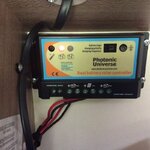- Aug 14, 2009
- 2,668
- 6,276
- Funster No
- 7,981
- MH
- Rapido V66
- Exp
- nowhere near long enough
Help just put a 120 watt solar panel on and on the controller I have an option to set it at 25, 50 or 100Hz. Not a clue what the difference is
Thanks
Thanks


